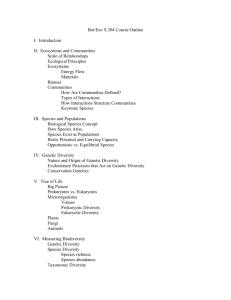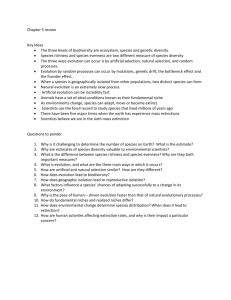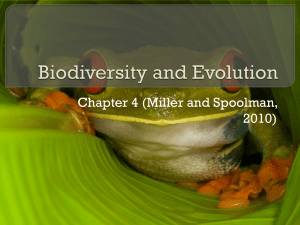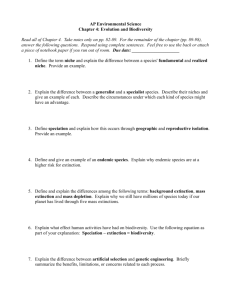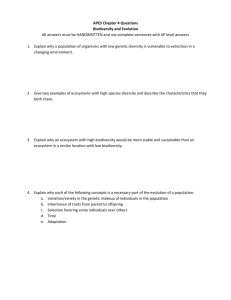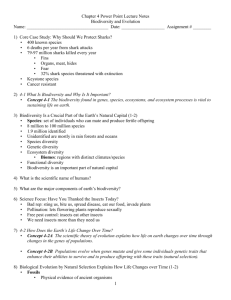Chapter 4 Biodiversity and Evolution
advertisement
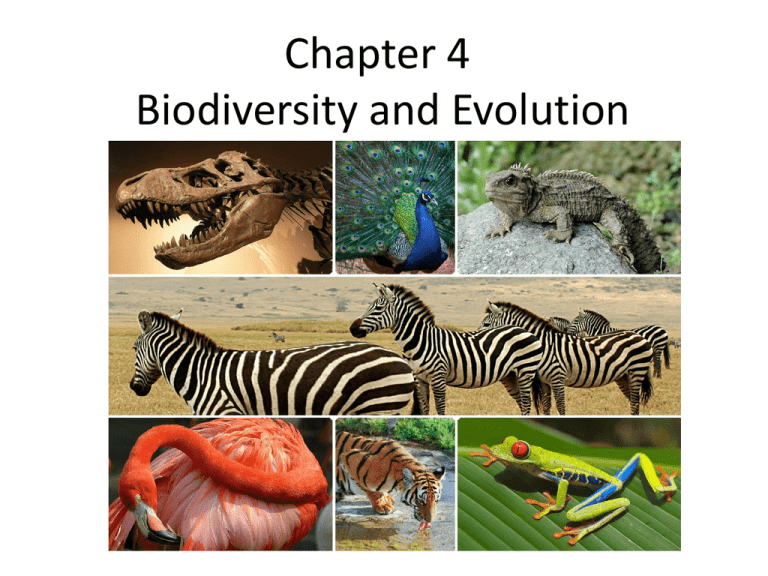
Chapter 4 Biodiversity and Evolution What is Biodiversity? It is the variety of earth’s species, the genes they contain, the ecosystems in which they live, and the ecosystems processes such as energy flow and nutrient cycling that sustain all life. Biodiversity is a vital renewable resource. It is this biodiversity that sustains us and our economies. The major components of earth’s biodiversity FUNCTIONAL DIVERSITY The biological and chemical processes such as energy flow and matter recycling needed for survival of species, communities, and ecosystems. GENETIC DIVERSITY The variety of genetic material within a species or a population. ECOLOGICAL DIVERSITY The variety of terrestrial and aquatic ecosystems found in an area or on the earth. SPECIES DIVERSITY The number and abundance of species present in different communities Species; where do they come from? • Biological Evolution by Natural Selection explains how life changes over time. – – – – Study of the Fossil Record Biological Evolution (genes changing in populations) Natural Selection (certain traits out survive others) Major scientific theory that explains how life has changed over the last 3.5 billion years Tree of Life Mutations and Adaptations • Mutations and changes in the genetic makeup of populations lead to biological evolution by natural selection. – Populations not individuals evolve by becoming genetically different – Mutations change genes in cells – Adaptive Traits improve ability to survive and most lead to differential reproduction – Genetic Resistance allows organisms to tolerate chemicals designed to kill it mutation adaptation How did Humans become such a Powerful Species? • Three Major adaptations – Strong opposable thumbs – Ability to walk upright – Complex brain These adaptations helped us develop technologies, tools, and devices, to help our survival. Adaption through Natural Selection has limits. Can adaptations to new environmental conditions through natural selection allow our bodies to adapt to current pollution problems? – NO, according to scientists in this field. • First, environmental changes can lead to adaptations only for genetic traits already present in a population’s gene pool or for traits resulting from mutations. • Second, even if a trait is present in populations, the populations ability to adapt may be limited by it’s reproductive capacity. • Species that reproduce quickly adapt in a short time • Species that reproduce slowly adapt in a long time Three Common Myths about Evolution through Natural Selection • 1. It is “Survival of the Fittest” not “Survival of the strongest”. (reproductive success) • 2. Organisms develop traits because they need or want them. (genes are already present) • 3. Evolution by natural selection involves some grand plan of nature in which species become more perfectly adapted. (appears to be random) Geological Processes and Climate Change Affect Evolution • Location of continents and oceans influence climate which determine where animals and plants can live • Movement of continents allows species to move, adapt, and form new species through natural selection, or become extinct. • Earthquakes and volcanoes can separate and Isolate populations, or destroy and habitats wiping out populations. • Climate change can occur rapidly killing off species and allowing other species to fill their roles. This also changes areas of habitability. • Asteroid impacts have also affected evolution through natural selection • Plate Tectonic Movement • Earth in 100 million years How do new Species Evolve? • Speciation – two species arise from one – Species evolve to a point they cannot reproduce successfully • Geographic Isolation – different groups of the same population of a species become physically isolated from one another for long periods • Reproductive Isolation – mutation and change by natural selection operate independently in the gene pools of geographically isolated populations. Humans are playing an increasing role in the process of speciation by shuffling genes through artificial selection, and genetic engineering. Speciation Extinction where an entire species ceases to exist • Can affect one species or many • Endemic Species are especially susceptible to extinction • Background Extinction is where species disappear at a slow rate • Mass Extinction is where large numbers of species are wiped out Extinction is a natural process, but much evidence indicates humans are major contributors to premature extinction. Golden Toads located in Costa Rica’s Monteverde Cloud Forest Reserve have become extinct due to changes in climate. It’s habitat has dried up due to changes in climate. Species Diversity • The number of different species contained in a community. • It is made up of Species Richness and Species Evenness. • Communities with high species richness tend to have low species evenness. Communities with low species richness tend to have high species eveness. Examples: • Tropical Rainforests have high many different species but there are only a few numbers of those species • Aspen Forests have a few different plant species but have large numbers of those species. Species Rich Ecosystems tend to be More Productive and Sustainable • Study by David Tillman and colleagues at the University of Minnesota found that communities with high species richness produced more, were more drought resistant, and were more resistant to insect invasion. They also consumed more carbon and nitrogen making them key players in those cycles. Roles Species Play in Ecosystems • Ecological Niche – Fundamental Niche – the possible niche that a species can occupy – Realized Niche – the actual niche or range in which a species actually exists – Where an organism lives and what it does in the ecosystem. – Niches can be occupied by a native or nonnative species Niche Breadth Generalists and Specialist • Generalists are organisms that have the ability to survive in a wide range of habitats. This may include the ability to utilize a wide variety of food, shelter, etc. • Specialists are species that survive in very specific habitats. They have adapted to eat very specific items and live in very specific habitats The Cockroach The Ultimate Survivor • Around for 350 million years because it is a generalist. • Eats almost anything, algae, dead insects, fingernail clippings, salts in tennis shoes, electrical cords, glue, paper, soap, their own dead and living. • Can live without food for a month and survive on a drop of water from a dishrag for a month. One species can be frozen for 48 hrs and still survive. • Have sensitive antennae and can respond faster than you can blink an eye. • Have compound eyes each with 2000 lenses compared to the one lens in each human eye. • Can detect poisons • Produce up to 10 million offspring in a year helping them develop genetic resistance really quickly. Indicator Species • Serve as biological smoke alarms. • Indicator species provide warnings of damage to a community or ecosystem. • Trout are only present in clean highly oxygenated waters. • Birds and Butterflies are highly susceptible to pesticides and habitat fragmentation. • Canary in the coal mine Importance of Amphibians • • • • Amphibians are sensitive environmental indicators They eat more insects than birds They are a vital food sources for other organisms They are genetic storehouses for pharmaceutical products. Painkillers, antibiotics, burn treatments, and heart disease • Amphibian populations have been declining across the globe. They are susceptible to the following: – – – – – – – – Habitat fragmentation Prolonged drought Pollution Increases in UV radiation Parasites Viral and Fungal disease Climate change Over hunting Keystone and Foundation Species Keystone Species – have a large effect on types and abundances of other species in an ecosystems. Example: Alligator Foundation Species – play a major role in shaping communities by creating and enhancing their habitats. Example: Elephant Protecting Sharks • Sharks remove injured and sick animals from the ocean • Sharks almost never get cancer • Sharks have highly effective immune systems which allow wounds to heal without becoming infected • Media portrays sharks as people eating monsters. • A few species of sharks injure approximately 60-100 people worldwide annually. • Poverty kills 11 million, tobacco kills 5 million, and air pollution kills 3 million people each year. • Ecological studies have shown that declines in shark populations have led to declines in bay scallop populations in the Atlantic Ocean. Species Richness on Islands • Refered to as Species Equilibrim Model or Theory of Island Biogeography • It is determined by 2 factors – Rate at which new species immigrate to the island – Rate at which species become extinct from the island • Model projects that at some point these two factors balance and determine the islands average # of species over time. • Small islands tend to have fewer species and fewer resources. Therefore, low immigration and high extinction rates which are opposite for large islands. • Islands closer to a mainland have higher species richness • This also occurs when habitats are fragmented for development.
